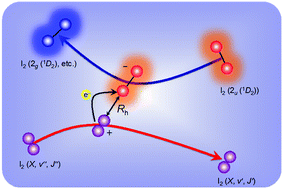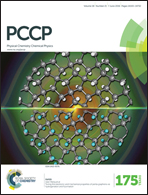Collision induced state-to-state energy transfer dynamics between the 2u (1D2) and 2g (1D2) ion-pair states of I2
Abstract
We report the first observation of collision induced state-to-state energy transfer from the 2u (1D2) (v2u = 3–7) ion-pair state of I2 using a perturbation facilitated optical–optical double resonance technique through the c 1Πg ∼ B 3Π(0+u) hyperfine mixed double-faced valence state as the intermediate state. The excitation of the 2u (1D2) state yielded the weak UV fluorescence from the wide range of vibrational levels in the nearby 2g (1D2) state. The vibrational distribution in the 2g (1D2) state derived by the Franck–Condon simulation of the UV fluorescence showed that the population in the 2u (1D2) state transfers mostly to the 2g (1D2) vibronic levels which are located energetically above the laser-prepared level. The radiative lifetimes and the self-quenching rate constants were determined to be 21.3 ± 0.1 and 44.6 ± 0.8 ns, and (1.30 ± 0.01) × 10−9 and (2.26 ± 0.17) × 10−9 cm3 molecule−1 s−1 for the 2u (1D2) (v2u = 3) and 2g (1D2) (v2g = 5) states, respectively. The rate constant for the 2u (1D2) – 2g (1D2) collision induced state-to-state energy transfer was also evaluated to be (1.89 ± 0.01), (3.07 ± 0.07), and (3.77 ± 0.05) × 10−10 cm3 molecule−1 s−1 for the v2u = 3, 5, and 7 levels, respectively. The very large self-quenching cross sections for the ion-pair states of I2 could be explained by the harpoon mechanism.


 Please wait while we load your content...
Please wait while we load your content...